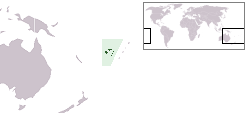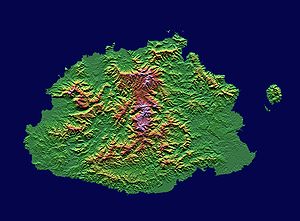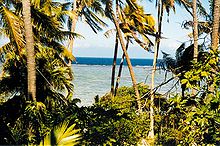Viti Levu
This articleneeds additional citations forverification.(September 2016) |
 Map of Fiji showing Viti Levu (one of its major islands) | |
 | |
| Geography | |
|---|---|
| Location | Pacific Ocean |
| Coordinates | 17°48′S178°0′E/ 17.800°S 178.000°E |
| Archipelago | Viti Levu Group |
| Area | 10,388 km2(4,011 sq mi) |
| Area rank | 75th |
| Length | 146 km (90.7 mi) |
| Width | 106 km (65.9 mi) |
| Highest elevation | 1,324 m (4344 ft) |
| Highest point | Tomanivi |
| Administration | |
Fiji | |
| Division | Western DivisionandCentral Division |
| Largest settlement | Suva(pop. 93,970) |
| Demographics | |
| Population | 740,000 (2022) |
| Pop. density | 55.83/km2(144.6/sq mi) |
| Ethnic groups | Native Fijians(54.3%), Indo-Fijians(38.1%); other (Asian,Europeans,otherPacific Islander) (7.6%) |
Viti Levu(pronounced[ˈβitʃiˈleβu];lit. 'Great Fiji') is the largest island in theRepublic of Fiji.It is the site of the nation's capital,Suva,and home to a large majority of Fiji's population.
Geology[edit]
Fiji lies in atectonically complex areabetween theAustralian Plateand thePacific Plate.The Fiji Platform lies in a zone bordered by active extension fault lines, around which most of the shallow earthquakes in the area have been centred. These fault lines are: the Fiji Fracture Zone (FFZ) to the north; the176° Extension Zone(176°E EZ) to the west; and the Hunter Fracture Zone (HFZ) andLau Ridgeto the east.[1]
The oldest rocks on the island are those formed during theEoceneandLower Mioceneepochs that belong to the Wainimalagroup.The lower portion of the group is made up ofvolcanicflows and volcanoclastics, which grade frombasalttotrachyteandrhyolite.Geographically, this group is found south ofNadi,including on the peaks of Koromba (at 3528 feet high) and Natambumgguto (at 1242 feet high), and down toSigatoka.From Sigatoka, the group extends almost all the way to Lodoni, and includes the peaks of Tuvutau (at 3060 feet) and Tikituru (at 3071 feet). Along the southern coast it extends almost toNausori.The group isintrudedby the TholoPlutonics,which consist of similar-agestocksoftonalite,granodiorite,gabbroanddiorite.Mio-Pliocenesandstones,andmarl,grading into epiclastics andandesiticVolcanic rocks of the Suva group are found mainly in the river valleys, such as those formed by theNadi RiverandNavua River.The Plio-PleistoceneMba group is found in the northern portion of the island. It consists ofporphyriticbasalt flows and volcanoclastics, grading intogreywacke.Geographically, it includes the peaks of Koroyanitu (at 3921 feet), Malua (at 3294 feet), Monavatu (at 3708 feet),Mount Tomanivi(at 4341 feet), and Ndelamendamu (at 2540 feet). It extends along the eastern coast, almost to Nausori, and includes the Emperor Mine nearVatukoula.[2][3]
Geography, economy and ecology[edit]


Viti Levu is the largest island in the Republic of Fiji — home to 70% of the population (about 600,000 people) — and is the hub of the entire Fijian archipelago. It measures 146 kilometres (91 mi) long and 106 kilometres (66 mi) wide, and has an area of 10,389 square kilometres (4,011 sq mi).Earthquakesand volcanic eruptions account for the somewhat rugged terrain of the island, which is divided into roughly equal halves by a mountain range that runs north to south. The centre of the island is forested and includes the nation's highest peakMount Tomanivi(otherwise known as Mount Victoria), which rises to 1,324 metres (4,344 ft).
The eastern side of the island experiences heavy rainfall, particularly in the mountains, and is home toFiji’s tropical moist forests.The western side (colloquially called the "burning west" ) is in the mountain range'srain shadowand is noticeably drier; it is home toFiji’s tropical dry forests.Accordingly,sugar caneproduction thrives in the west, while adairyindustry is being developed in the east.[citation needed]Fiji's largest cattle ranch, with 7000 head of cattle on 70 square kilometres (17,000 acres), is in Yaqara, midway betweenTavuaandRakiraki.The island of Viti Levu is the only known home of one of the world's largest insects, theGiant Fijian long-horned beetle.
The island is susceptible to the effects of climate change. It is estimated that the compound effects ofsea level riseandstorm surgemay result in a temporary relocation of a relatively high numbers of the inhabitants of Viti Levu, predominantly the northern and western parts, with an exposure of up to 6.75% of the islands' population in the future.[4]
Localities[edit]


Viti Levu is home to the capital city ofSuva,and to nearly three quarters of the population of the Republic of Fiji (about 580,000 people). Other important towns and cities, which are spread out all along the coast, includeBa,Lautoka,Nadi,Nausori,Rakiraki, andSigatoka.Two other well-known localities areNatadola Beachin Natadola (a luxurious Intercontinental Fiji Golf Resort and Spa & boutique accommodation at Natadola Beach Resort & Yatule Beach Resort), andPacific Harbour(a resort centre about 50 kilometers from Suva). A single major road runs around the perimeter of Viti Levu.
Politics[edit]
Eight of Fiji's fourteenProvincesare in Viti Levu. The Provinces ofBa,Nadroga-Navosa,andRacomprise theWestern Division,whileNaitasiri,Namosi,Rewa,Serua,andTailevuform theCentral Division.The political dynamics of western Viti Levu are somewhat different from those of eastern Viti Levu, in part because western Vitu Levu has a high concentration ofIndo-Fijians(many of whose ancestors came to the island fromIndiaas indentured workers between 1879 and 1916), whereas eastern Viti Levu has a high concentration ofindigenous Fijians(except in its urban areas, which are more racially diverse).
History[edit]
Prehistory[edit]
Viti Levu is believed to have been inhabited longer than the island ofVanua Levu,which lies to its north. According to oral tradition, the firstMelanesiansettlers landed atVuda Pointand establishedViseiseias Fiji's first oldest settlement. There is archaeological evidence contradicting this account.
Transportation[edit]
Ferry service, provided by thePatterson Brothers Shipping Company LTD,connects Viti Levu to the rest of the islands.
Nausori International Airportis on the main island. It has service on 3 domestic commercial passenger airlines.
References[edit]
- ^Greenbaum, D.; Bowker, M. R; Dau, I; Drospy, H; Greally, K. B; McDonald A. J. W; Marsh, S. H; Northmore, K. J; O'Connor, E. A; Prasad, R. S & Tragheim, D. G. (1995)."Landslide hazards in Fiji"(PDF).Technical Report WC/95/28 Rapid methods of landslide hazard mapping: Fiji case study.British Geological Survey.Retrieved23 March2011.
- ^Provisional Geologic Map of Fiji.Suva: Fiji Geological Survey. 1965.
- ^Rodda, P. (1967)."Outline of the geology of Viti Levu".New Zealand Journal of Geology and Geophysics.10(5): 1260–1273.doi:10.1080/00288306.1967.10420217.
- ^Sabūnas, Audrius; Mori, Nobuhito; Shimura, Tomoya; Fukui, Nobuki; Miyashita, Takuya (8 April 2022)."Estimating Compounding Storm Surge and Sea Level Rise Effects and Bias Correction Impact when Projecting Future Impact on Volcanic Islands in Oceania. Case Study of Viti Levu, Fiji".Frontiers in Built Environment.8.doi:10.3389/fbuil.2022.796471.
